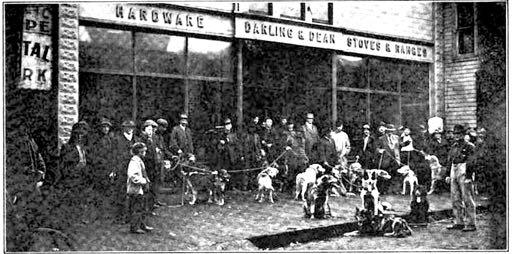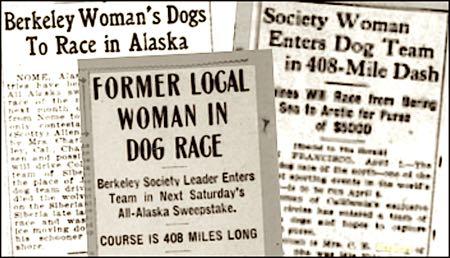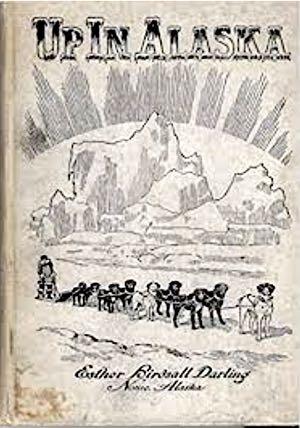
11 minute read
ESTHER BIRDSALL DARLING

Esther Birdsall Darling with her racing dogs Tom (middle), Dick, and Harry, “the famous Tolman brothers, who were the Veterans of Alaska Dog Racing, and so had a standing in the Kennel that none dared question.” ~from the book, Baldy of Nome
Advertisement

Sacramento Union, April, 1912
Esther Birdsall Darling
Author of ‘Baldy of Nome,’ Kennel Partner to A. A. “Scotty” Allan
On the front page of the Los Angeles Herald, April 2, 1911:
Society Woman Enters Dog Team in 408-Mile Dash Canines Will Race from Bering Sea to Arctic for Purse of $5OOO
[Special to The Herald] SAN FRANCISCO, April 1. The great dog race of the north—one of the greatest sporting events in the world’s history—is to be run April 8. A woman of California's exclusive society circles has entered a team of fourteen dogs and hopes to capture the $5000 purse. The woman is Mrs. C. K. Darling of Berkeley. She was Miss Etta Birdsall of Sacramento, sister of Senator Birdsall of Placer. The Birdsalls have always been welcomed in the foremost society of California. Mrs. Darling is the intimate friend of Mrs. William H. Crocker, Mrs. George Sperry, Mrs. Mountford Wilson, Mrs. C. O. Alexander and other society leaders. The race is the All-Alaska Sweepstakes—a contest for dog teams over a course 408 miles long, from the Behring Sea to the Arctic Ocean and return. The race was won last year by the Earl of Dalhousie. with the Earl’s brother in a parka driving the second team. Mrs. Darling owned the third team, and this year she is determined to win the first place. Her fourteen picked dogs are ready for the start. Her driver is Scotty Allan, "King of the Trail.”

Esther’s father purchased 70 acres overlooking the American River Canyon for his olives.
Esther Birdsall was born into wealth and privilege, the daughter of Frederick and Esther Stratton Birdsall, natives of New England, who were prominent in the early history of northern California. Born in 1868, and known as Etta when she was younger, Esther grew up in a fine home, tended by three live-in servants, in the state capitol of Sacramento.
A respected businessman, her father had interests in a store, a narrow gauge rail line, a silver mine in Nevada’s famous Comstock Lode, and he was an organizer and director of the Sacramento Bank. He was the owner of a water distribution network known as the Bear River Ditch, originally used to supply water to the mining camps for prospecting, and he later turned that into the first agricultural irrigation system in the county. In the mid-1870s, ranchers in the southern part of the state were enjoying success in growing olive trees, and pioneering horticulturists - including Birdsall - decided to add olives to their new fruit-production industry, as state agriculturists felt olives would do well in the moderate climate of the Sierra Nevada foothills. Frederick Birdsall purchased 70 acres overlooking the nearby American River Canyon and built a ranch which would become known asAeolia, for themythological Greek god of the winds, Aeolus.

Franklin Birdsall traveled to Europe to learn about olive growing, then planted thousands of olive trees at Aeolia Heights. Over time, his Aeolia Olive Oil would win many awards.
When Etta was a young teenager she accompanied her father to Europe, where he learned about the olive oil industry. Birdsall returned to his California ranch with several thousand highquality olive varieties, and he and his wife had a beautiful home built near the top of the mountain, with the willowy olive orchards fanning out around them, and raised their five children.
In 1922 Esther wrote about life at Aeolia Heights for the Placer Herald newspaper, describing the menagerie which came into their possession by various means: “…in addition to our two collies and two cats, a monkey, a disabled blue-jay, a mud turtle, an orphaned lamb, an abused and abandoned water spaniel, and a white rat…”
Many years later Esther would dedicate her most famous book, 'Baldy of Nome,' to her mother: “To My Mother, whose unfailing kindness to all animals is one of my earliest and happiest memories.”
By 1890 the Birdsalls had built an olive oil processing plant on their land, and the Birdsall company's "Pure California Olive Oil" won numerous awards at agricultural fairs and exhibitions. Etta attended Mills College in Oakland, the first women’s college west of the Rocky Mountains. After graduation she spent a number of years traveling, visiting London, Paris, Constantinople, the Sahara Desert, Mexico, Hawaii and the Orient. Her brother, Ernest Stratton Birdsall, took over management of the family ranch and olive oil company when their father died in 1900. He also became a leader in government, winning election to the state assembly in 1907, and serving as a state senator from 1909 to 1917. Today there is a quartz monument at a local intersection recounting the Birdsall family's history and their contributions to the community.
In 1907, at the relatively late age of 38, Esther married the co-owner of the Darling & Dean Hardware business in far-off Nome, Alaska. The frontier town had been established only a few years before, when gold was found in 1898. Its rough edges were still evident, but by the turn of the century Nome had a population of over 10,000, making it the largest city in the Alaska Territory, yet only accessible by foot, dogsled or steamship.

The sled dogs of the Stefansson Expedition had formerly carried the mail to Nome. C. E. Darling, ‘Scotty’ Allan, and Vilhjalmur Stefansson are among the men seen here at Darling & Dean.
Charles Edward 'Ned' Darling was born in Ireland in 1871. He was working for a west-coast based paint company in 1900 when he decided to transport a supply of fireproof paint to the Nome gold camp for fire-proofing the miners’ tents. After looking things over he determined that a hardware store could prove profitable, and by 1915 his store, the farthest north hardware store on the American continent, would boast a $150,000 inventory of hardware, ship chandlery, roofing, dredging supplies, and mining and mill supplies. Darling & Dean Hardware outfitted several Arctic expeditions, including explorer and anthropologist Vilhjalmur Stefansson, who in 1913 purchased $21,000 in supplies for a three-year scientific study of the Arctic.
Charles Darling was also a musher, and in February of 1906 he set a world’s record for long distance mushing when he drove his dog team from Nome to Seattle—via Valdez and ship—in only 42 days. Dog teams were held in high esteem, for a string of strong huskies was the most reliable mode of transportation over winter trails. The secretary of Darling & Dean Hardware, a Scotsman named Allan Alexander Allan, known as “Scotty,” partnered with Charles Darling in a dog kennel, and when the new Mrs. Darling met the furry residents of this kennel it was love at first sight, and that love would blossom into a literary legacy.

Ned Darling posing on Front Street in Nome with his sled dog team before departure for Seattle. The trip took him 42 days and set a new record. Photo by Frank Nowell, February 2, 1906.
Scotty Allan played a key role in the founding of the Nome Kennel Club in 1907, and Esther would later serve as president of the organization. The club organized the first sled dog race with official regulations, held in Nome in 1908, running 408 miles, north to the mining camp of Candle and returning to Nome. The course traversed the forbidding Seward Peninsula, a land so remote and treacherous that few travelers dared cross the wide and wind-blown expanse. But Scotty Allan, who had been one of the first mail carriers over the route between Valdez and Nome, thrived on the challenges presented in the Sweepstakes race. He won the race in 1909, 1911 and 1912, with the inimitable Baldy leading. Scotty had acquired Baldy from a boy named Ben Edwards, who he gave a job in the kennel, and the dog would become so famous that his race wins were reported in The New York Times and other national newspapers.
The First World War interrupted the All Alaska Sweepstakes races, and an article in a 1918 edition of the trade magazine Hardware World, which grandly profiled the Darling & Dean Hardware store, explained a little of the ‘rest of the story’ regarding the dogs: “….Operating the fartherest [sp] North and most Western hardware store is not the only claim for recognition which Mr. Darling admits. Rather it is he is fortunate in being the husband of Mrs. Esther Birdsall Darling. His business requiring most of his attention, he gave to her his interests in the Allan-Darling Alaskan dog team.
“We can only briefly refer to a few things, but if you want to hear someone put the ‘human touch’ and tell the story of the wonderful work of Alaskan dogs, Mrs. Darling can give you a true and vivid picture. Her addresses and lectures are most interesting. Someone has said, ‘money can buy everything except the wag of a dog’s tail.’ He instinctively knows who is his friend. Mrs. Darling has been the friend of many wonderful Alaskan dogs.

Winners of the 1911 All Alaska Sweepstakes, Scotty Allan, driver
“It will be surprising to most of our readers to know that in France 10,000 dogs are now serving the cause of the Allies. The start was first made by securing 450 Alaskan dogs and shipping them to France, and their number has been increased and other dogs have been purchased, so valuable have the first proved. In fact, Mrs. Darling has the Croix de Guerre awarded to her dog team in recognition of relief and rescue work they have accomplished. The work the dogs are doing as carriers or sled dogs, pulling ambulances, doing Red Cross relief work, guarding munitions and prisoners, and serving as messengers and carriers, is probably given little thought. They seem never to tire, and it is only death or a serious wound that can stop them. In their war work the dogs are used in teams of fifteen to twenty each. The AllanDarling Alaskan dogs have had their pictures painted and hung in the Museum of War in recognition of the wonderful service rendered. They have their regular camps and keepers and are an important unit.”

In a 1916 booklet Esther shared the history of the Great Dog Races of Nome: the All Alaska Sweepstakes, the Solomon Derby, the Ruby Derby and the Fort Davis Races. Additional pages below:




Esther’s name was often in the newspapers, as shown by these news clippings from the Los Angeles Herald, 1911; Sacramento Union, 1911; and the San Francisco Call, 1912.
The article then turns to the Alll Alaska Sweepstakes, and notes, “The man who is the most careful and takes the best care of his dogs stands the best chance of winning and that is the reason why the Allan-Darling dog teams have won the race more times than all competitors put together. It was this training and education that first attracted the French government to their work and which has since proved such a wonderful help in this world conflict.
“Mrs. Darling did not think at the time she began devoting attention to Alaskan dogs that they would play such an important part in saving human lives, but now that they are on the battlefield, she is devoting her time, both with spoken and written word, contributing to various charitable and patriotic institutions. Her book, Baldy of Nome, named after one of her famous dogs, has had a wide sale, and is one of the most interesting books of the year.”

'Baldy of Nome,' published in 1912, was kept it in print by popular demand for more than forty years. It was filled with exciting true stories such as the time during the 60-mile Solomon Derby when Scotty, leaning over his sled to look at a broken runner, hit his head on an iron trail marker and was knocked unconscious. Baldy stopped the team, returned to his injured driver and roused him with nudges and howls, and then led the team to win the race. Stories of Baldy’s descendants followed, including Boris, Grandson of Baldy; Navarre of the North, and collections of prose and poetry about Alaska.
Charles and Esther Darling left Alaska in 1918 and moved to Berkeley, California, and so also did Scotty Allan, taking along his old friend and trail mate Baldy. When Baldy died in 1922 Esther Darling and Scotty Allan obtained a special permit from the city to bury the famous dog in the back yard of the Allan home in Oakland, overlooking San Francisco Bay. A rose bush was planted over his grave, and a lengthy obituary ran in The New York Times.
Charles Darling died in May, 1923, after which Esther lived alone in an apartment on Durand Street with pictures of Alaska on all of the walls, and several big silver cups won by Baldy. There was one rare photograph which Esther reportedly cherished. Taken August 15, 1935, it was a photo of the famed humorist Will Rogers, the noted airman Wiley Post; famous Alaskan bush pilot Joe Crosson, and champion musher Leonhard Seppala, another three-time All Alaska Sweepstakes winner and a hero of the 1925 Serum Run to Nome. The four friends were standing on a dock near Fairbanks in front of Wiley Post's floatplane, shortly before it crashed into a pond near Barrow, killing Rogers and Post.
Esther Birdsall Darling spent her later years as a popular speaker at civic, charity, and other social events, describing life in Alaska during the heyday of the All Alaska Sweepstakes to her attentive audiences. She was justifiably proud of her partnership with A. A. “Scotty” Allan, who she always described as the best dog man in Alaska, and their champion leader Baldy. Esther passed away June 2, 1965, at the age of 96, in Auburn, California, near her childhood home. She was buried in the Sacramento City Cemetery, close to her parents and her husband. ~•~









